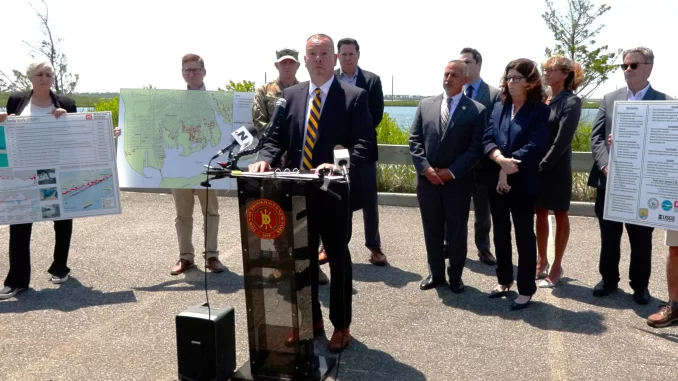
On June 13, Brookhaven Town Supervisor Dan Panico held a press conference with local elected officials, the U.S. Army and representatives to announce the launch of the first phase of the Fire Island to Montauk Point (FIMP) home elevation program.
The FIMP project, which is well underway, is a far-reaching multibillion-dollar initiative to reduce flood risk in vulnerable areas along 83 miles of coastline from Fire Island Inlet to Montauk Point. This partnership benefits Brookhaven residents in low-lying communities of the town’s south shore and Fire Island barrier beaches by reducing the risk of flooding from storms to shoreline homes, businesses, and infrastructure.
Homeowners can elect to take part, or stay out, of the program. Eligibility was determined by the U.S. Army Corps of Engineers based on a property’s scale, size, estimated cost of construction, and location within the 10 percent ACE FEMA floodplain. Roughly one-third of the 4,400 eligible homes in Suffolk County are located in Brookhaven; 1,200 properties within Brookhaven have been pre-identified as eligible by the U.S. Army Corps of Engineers. If a home is not pre-identified as eligible by the U.S. Army Corps of Engineers, the homeowner may still apply for consideration within this program. Applications of this nature will be assessed individually. The map and list of eligible homes can be accessed directly at brookhavenny.gov/FIMP.
The project is 100 percent federally funded and does not require local matching contributions. The funding was allocated within the Sandy Disaster Relief Supplemental, Public Law 113-2. The project will bring a $1.57 billion investment to Long Island; approximately $900 million is allocated to cover the home elevations.
“In the Town of Brookhaven, there are approximately 200 homes in Mastic Beach alone that are identified as potentially eligible for the pilot program,” Panico said. “Our beautiful shoreline and the homes within the FIMP zone are currently in danger of severe damage or total destruction from future storms. I thank the U.S. Army Corps of Engineers for working with the Town and County to help our residents preserve their homes and keep our shoreline safer from storms and the destruction that they cause.”
Steve Castleton, former Civilian Aide to the Secretary of the Army said, “From back when I had 50 soldiers working with me after Hurricane Sandy doing rescue and recovery, this is a dream fulfilled. This partnership will protect Long Island for generations to come.”
Brookhaven Town Councilwoman Karen Dunne Kesnig, who represents Mastic Beach added, “The FIMP plan offers a path forward and a lifeline for many people in Mastic Beach and along Brookhaven’s south shore who may soon be priced out of their homes due to rising flood insurance premiums. Our office is going to continue to work diligently to get information out to the public once the Army Corp moves further into the process of signing up prospective homeowners.”
While the federal government is currently finalizing the details with NYSDEC, New York State is expected to request participation in the temporary relocation assistance program that authorizes the Corps to reimburse relocation costs to homeowners for up to $20,000. Under this program, homeowners would be reimbursed up to $20,000 for temporary housing costs. Provisions for advance payment are available to homeowners who demonstrate a hardship in making payments and seeking reimbursement.
The U.S. Army Corps of Engineers is set to roll out a public outreach initiative by the end of July to communicate accurate information to the residents, address issues, and field concerns.
The FIMP program is a labor-intensive undertaking that will take several years to complete. Every participating home/structure must be individually evaluated by inspectors from the local jurisdictions and the Army Corps of Engineers to determine flood-risk needs and create a design to reduce that risk adequately. To be chosen for elevation, structures must have an issued CO and comply with local building codes and regulations. The U.S. Army Corps of Engineers expects to begin taking applications around late August, or early September. Additional information will be published about the application process during the outreach period.
Details of structural elevations are available from the New York District’s website at www.nan.usace.army.mil. The Army Corps of Engineers is planning a phased approach: first, to identify a small portion of the structures that may be eligible, assess structures, determine designs, construct, and learn from the initial phase; then broaden the structure inventory to enable more participation.
One FIMP program was completed in February, when the Army Corps placed 450,000 cubic yards of sand restoring a badly eroded shoreline in downtown Montauk.
Due to a string of severe storms last fall/winter that severely eroded many coastal areas, the Army Corps determined that several areas met the eligibility determination for emergency funding. They subsequently received emergency funding for sand placement in eastern Fire Island, including the communities of Seaview, Ocean Bay Park, Cherry Grove, Fire Island Pines, and Davis Park. Sand placement will cover approximately 44,000 linear feet – nearly 9 miles – and will require approximately 2 million cubic yards of sand. Sand will be sourced from an approved offshore borrow area where our District already has a dredging permit.
The Army Corps recently completed beach renourishment work on the western end of Fire Island and will continue coordination with residents throughout the entire community to increase resiliency across the board. The Corps will execute a phased approach; first to identify a small portion of the identified structures that may be eligible, assess structures, determine designs, construct, and learn from the initial phase; and then broaden the structure inventory to enable more participation.

